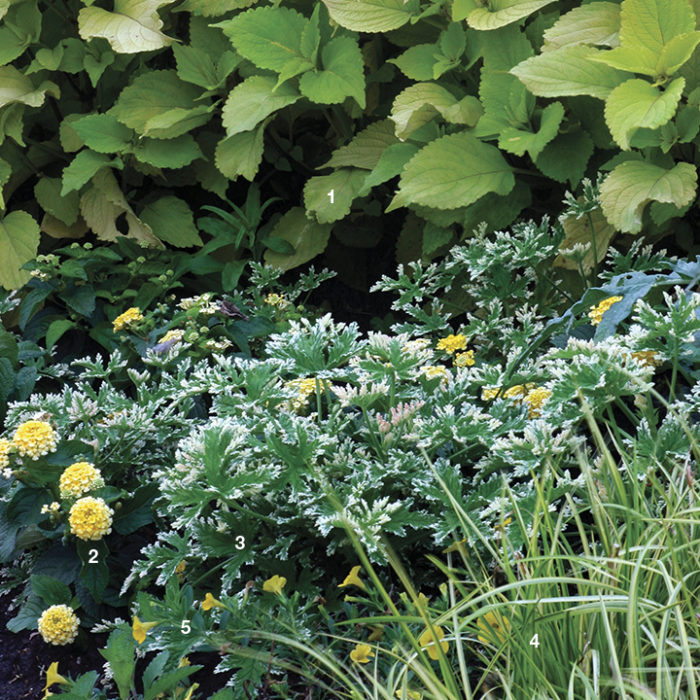
Annuals supply shocking color, quickly grow to maturity, and provide the “wow” factor we all want from our gardens. But historically, gardens have been segregated by plant group: vegetables in the sunny spots, perennials around the foundation of the house, trees and shrubs in the lawn, and annuals in an area adjacent to the front entrance of the home—sadly underused.
The growing trend of container gardening, though, has emphasized annuals and their ability to provide great one-season performance while also offering gardeners the flexibility to change them from season to season. Annuals, no longer just container and entryway plants, are now appreciated for their ability to mingle with other plants and boost beauty in every area of the landscape.
Finding annuals that can provide big results is easy. Here in Minnesota, I use true annuals in my landscape, along with other plants that I treat as annuals even though they may be perennials in other zones. I mix these plants into the landscape and get bold, almost instant impact in my garden. The secret for achieving these quick, dramatic results is in learning how to combine the right plants and apply the correct techniques to get the most from these one-season wonders.
Compare and contrast
To create a successful garden scene, like and unlike elements should define the space. Contrasting plants and colors add interest, while similar details provide unity and prevent the appearance of chaos.

1. Contrasting light and dark makes a bold statement. The vibrant yellow of variegated flowering maple keeps the dark colors of ‘Intrigue’ canna lily and ‘Tangletown’s Dark Secret’ coleus from blending together.
2. A continuous border of yellow would be overkill, but this subtle repetition of yellow links one garden space to the next, while still allowing for a series of dramatic combos in between.
Plant linking makes designing easy
I start combining my annual combos using a basic technique that I call “plant linking.” It’s a simple method for creating combinations anywhere. All gardeners have heard of the “thriller, filler, and spiller” container concept. This is a good rule, but it really doesn’t help you put plants together. Plant linking does.

1. Variegated purple fountain grass (Pennisetum setaceum ‘Fireworks’, USDA Hardiness Zones 9–11)
2. ColorBlaze® Dipt in Wine coleus (Solenostemon scutellarioides ColorBlaze® Dipt in Wine, Zone 11)
Go to the garden center where you can actually see and touch the plants, as opposed to looking at a thumbnail image on your computer. Select a plant that you are really drawn to. Walk around the garden center with it until you find another plant that not only shares a characteristic with your plant choice but also provides a contrast. An effective combination can be achieved in a simple two-plant scene. One of my favorite combos is a burgundy grass paired with a coleus that contains that same color as well as a contrasting chartreuse to break things up a bit.
Linking can involve as many steps as you like, but I’ve found that if you go beyond six plants, then your garden starts to look disorganized. A good example of plant linking with a limited number of plant varieties is this five-member combo. I started with a favorite coleus of mine: ‘Big Blonde’. It’s a robust, vigorous coleus that can add a punch to any combination. (Give it lots of room, though, as it really lives up to its name). I linked this coleus to golden dwarf sweet flag because of the shade of yellow they both share. From there, I added ‘Frosted’ geranium to the combo because it shares a common shade of cream with the sweet flag. I rounded out the combo with Luscious® Lemonade lantana and Superbells® Yellow calibrachoa to add a floral component and because of their connection to both the coleus and the sweet flag. I now have a group of five plants that are all related to each other in some way yet still add enough contrast to provide a fabulous show.

1. ‘Big Blonde’ coleus (Solenostemon scutellarioides ‘Big Blonde’, Zone 11)
2. Luscious® Lemonade lantana (Lantana camara ‘Robpwcrm’, Zones 9–11)
3. ‘Frosted’ geranium (Pelargonium citrosum ‘Frosted’, Zones 10–11)
4. Golden dwarf sweet flag (Acorus gramineus ‘Ogon’, Zones 6–9)
5. Superbells® Yellow calibrachoa (Calibrachoa ‘USCAL53002’, annual)
Annuals provide coverage and add beauty
In my garden, annuals serve two primary functions: real-estate management and beauty. I often use groups of annuals to manage the space between woody plants and perennials as they mature. The annuals provide great seasonal color in an area that would otherwise be bare mulch until the neighboring plants filled in. I plant fewer annuals as the available area shrinks and the permanent plants reach maturity.
For my front-entry garden, I planted weeping white spruce and false cypress far enough apart so that they have plenty of room to mature into beautiful specimens. Small groups of coleus and canna lilies fill in the remaining void.
Achieving beauty is a bit trickier. Too many colors and varieties can create a confusing scene rather than one of beauty. Even though my garden has evolved to include countless varieties across the plant spectrum, I use simple ideas to determine what plants to include.
I rely heavily on foliage plants. Whether a plant is an annual or a perennial, its flowers come and go but its foliage is long lasting. This is evident in the coleus, canna lily, and flowering tobacco combo in my front-entry garden. When the flowering tobacco finishes a bloom cycle, the foliage takes over and carries the weight. Flowers are the frosting, while foliage is the cake.

1. ‘Pendula’ weeping white spruce (Picea glauca ‘Pendula’, Zones 2–6)
2. ‘Red Ruffles’ coleus (Solenostemon scutellarioides ‘Red Ruffles’, Zone 11)
3. ‘Australia’ canna lily (Canna‘Australia’, Zones 8–11)
4. ‘Golden Mop’ false cypress (Chamaecyparis pisifera ‘Golden Mop’, Zones 4–8)
5. Royal Queen™ Purple iochroma(Iochroma cyaneum ‘Purple Queen’, Zones 9–11)
6. Flowering tobacco (Nicotiana langsdorffii, annual)
7. Summer Wave® Blue torenia (Torenia ‘SUNrenilabu’, annual)
Another useful design scheme I use to create beauty is contrasting plant schemes. A basic dark-versus-light plant combination can be used with any two strongly contrasting colors to produce bold results. I start off one of my streetside combos with a dynamic plant: ‘Intrigue’ canna lily (Canna ‘Intrigue’, Zones 8–11). ‘Intrigue’ provides a contrast with the light-toned variegated flowering maple (Abutilon cv., Zones 8–11), while ‘Tangletown’s Dark Secret’ coleus (Solenostemon scutellarioides ‘Tangletown’s Dark Secret’, Zone 11) repeats the previous dark burgundy.
When planting large areas of annuals, it is important to also use repetition of color throughout the garden to tie different spaces together. Repetition gives continuity and flow to a garden, and even though you may have a lot going on, it gives the garden a true sense of design. A strong foliage color works best to accomplish this. The yellow foliage found in the dark-versus-light combo, for example, is duplicated in a nearby combo, connecting one unique design back to another. With all that annuals can accomplish, they will forever be a part of my ever-changing garden, providing an opportunity for a new and unique look each season.
When it comes to plant linking, seeing is believing
This sample plant combo shows how simple plant linking can be. You could even remove one of the elements and the group would still work.
 |
 |
 |
| Royal Queen™ Purple iochroma (Iochroma cyaneum ‘Purple Queen’, Zones 9–11)
Bold purple blooms provide a starting point for plant linking. |
‘Big Blonde’ coleus (Solenostemon scutellarioides ‘Big Blonde’, Zone 11)
Subtle purple veining links this plant to the iochroma, while yellow foliage establishes contrast. |
Cabaret™ Purple calibrachoa (Calibrachoa Cabaret™ Purple, annual)
Too many purple blooms? Not when you add the subtle contrast of yellow throats. |
 |
 |
| Golden creeping Jenny (Lysimachia nummularia ‘Aurea’, Zones 4–8)
There’s room for more foliage. Golden leaves keep up the pattern. |
Golden Moon™ torenia (Torenia Golden Moon™, annual)
Need more blooms? Yellow petals and purple throats provide repetition and contrast. |
Dean Engelmann is co-owner and operator of Tangletown Gardens in Minneapolis.
Photos: Brandi Spade. Sidebar photos: courtesy of Dean Engelmann.
Fine Gardening Recommended Products

ARS Telescoping Long Reach Pruner
Fine Gardening receives a commission for items purchased through links on this site, including Amazon Associates and other affiliate advertising programs.

The Regenerative Landscaper: Design and Build Landscapes That Repair the Environment
Fine Gardening receives a commission for items purchased through links on this site, including Amazon Associates and other affiliate advertising programs.

A.M. Leonard Deluxe Soil Knife & Leather Sheath Combo
Fine Gardening receives a commission for items purchased through links on this site, including Amazon Associates and other affiliate advertising programs.


















Comments
Log in or create an account to post a comment.
Sign up Log in